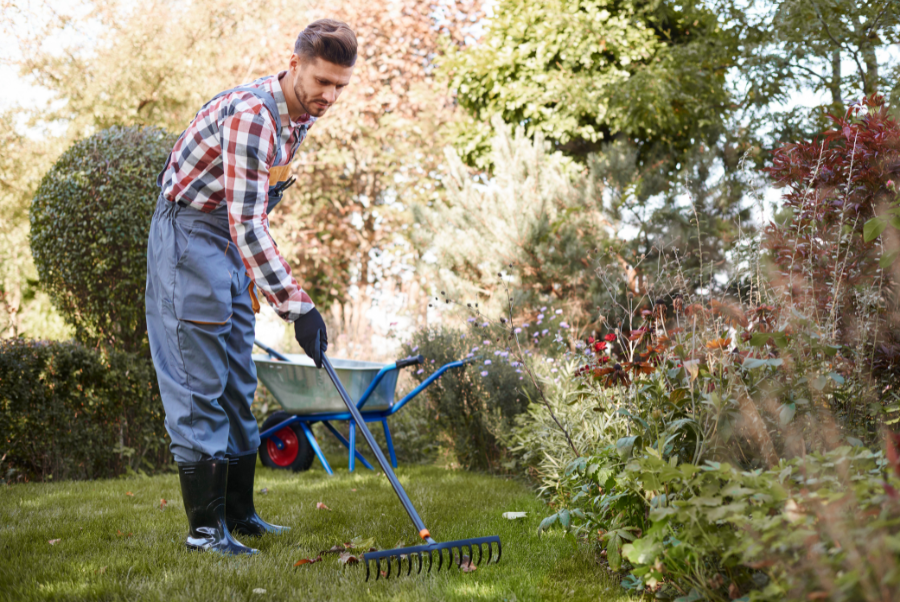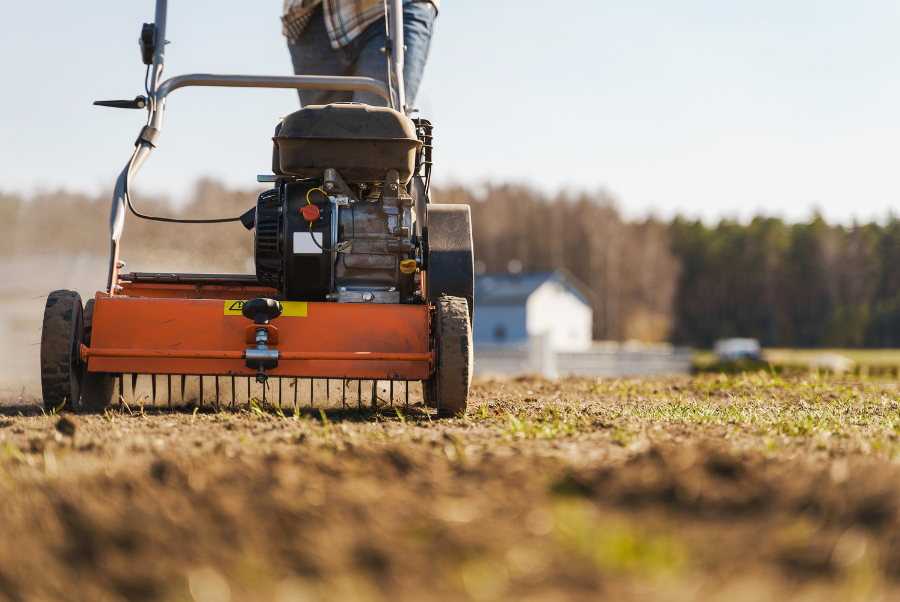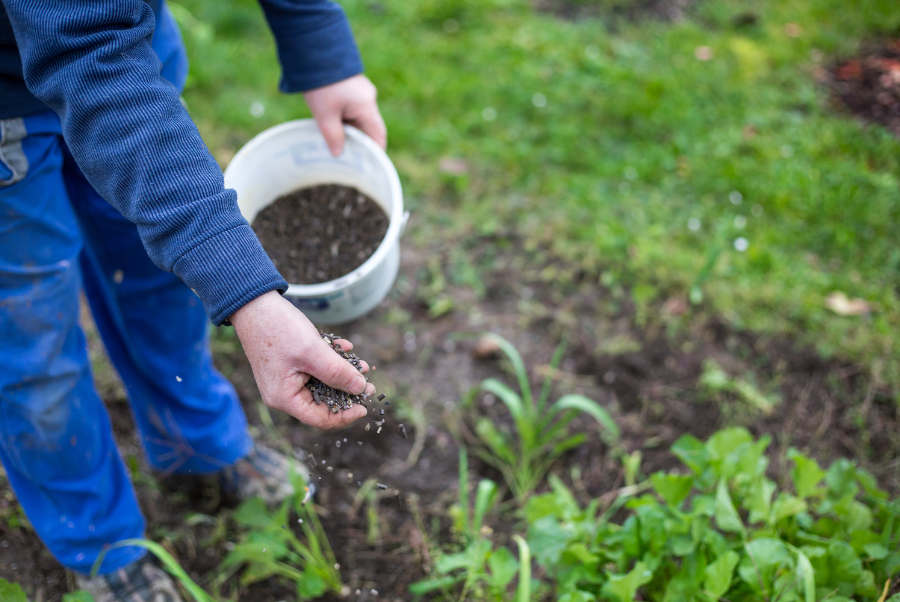Why Spring Lawn Care Matters
Spring is the season of renewal—not just for nature but for your lawn as well. After months of winter dormancy, your grass needs special attention to recover and thrive during the growing season. Spring lawn care is essential to achieve a lush, healthy lawn that boosts your property’s curb appeal and provides a perfect outdoor space for relaxation or gatherings.
At Doug Greenwood Landscaping Co., located at 33 Carr St, Coventry, RI, we specialize in providing professional lawn care and landscaping services. Whether you need a complete Spring Clean Up, expert landscape design, or a new installation, our services ensure your lawn looks its best all year long.
In this guide, we’ll cover 10 powerful steps for spring lawn care to help homeowners in Coventry, RI prepare their lawns for a vibrant season. Following these steps not only improves the health of your lawn but also sets the foundation for a sustainable maintenance plan.
Step 1: Conduct a Thorough Lawn Inspection
A healthy lawn starts with a comprehensive inspection. Begin by walking around your yard and observing its current state. Look for:
- Bare spots: These often result from snow mold, foot traffic, or pests during winter.
- Pests and weeds: Inspect for early signs of crabgrass, dandelions, or grubs.
- Soil issues: Check for compacted soil or areas where water pools after rain.
How to Perform an Effective Lawn Inspection
- Use a soil probe or spade to check soil quality and compaction levels. Healthy soil should be loose and slightly moist.
- Note any areas of discoloration—yellow or brown patches may indicate fungal diseases or poor nutrient availability.
- Create a list of problem areas to address in your lawn care plan.
Pro Tip: If you’re unsure about soil health or pest problems, consider hiring a professional lawn care service like Doug Greenwood Landscaping Co. for expert advice and solutions tailored to Coventry’s local climate.
Planning Your Spring Lawn Care Strategy
Once you’ve identified your lawn’s issues, create a plan to address them step by step. Prioritize tasks like aeration for compacted soil, reseeding for bare spots, and weed removal for healthier grass growth.
Step 2: Spring Clean Up

A successful spring lawn care routine begins with a thorough cleanup. Winter often leaves lawns cluttered with fallen branches, leaves, and debris that can smother grass and invite pests. Cleaning up your yard not only improves its appearance but also prepares the grass for healthy growth.
Why Spring Clean Up is Essential
- Prevents mold and disease: Decaying organic matter can lead to fungal growth, which hinders grass recovery.
- Improves sunlight exposure: Clearing debris ensures that grass gets adequate sunlight, essential for photosynthesis.
- Encourages new growth: Removing barriers allows the soil to warm up faster, promoting seed germination and root development.
How to Perform a Thorough Spring Clean Up
Follow these steps to ensure a clean and healthy start to the season:
- Rake the Lawn
Use a flexible rake to remove leaves, sticks, and dead grass (thatch). Focus on areas where debris may have accumulated over winter.- Pro Tip: Avoid aggressive raking as it can damage tender grass blades.
- Clear Garden Beds
Remove leaves and debris from flower beds and shrubs. This reduces the risk of pests like slugs or aphids taking residence. - Remove Dead Branches
Inspect trees and shrubs for dead or broken branches caused by winter storms. Trim them to prevent damage during spring winds. - Edge and Define Borders
Redefine the edges of your lawn, garden beds, and walkways. This instantly enhances curb appeal while keeping grass growth in check.
Professional Spring Clean Up Services
For a stress-free experience, consider hiring Doug Greenwood Landscaping Co. for expert Spring Clean Up services. Our team uses specialized tools and techniques to clean your yard efficiently while preserving its integrity.
Environmental Benefits of Clean Up
A well-maintained lawn is also eco-friendly. Clearing debris reduces the risk of groundwater contamination and supports the ecosystem by providing a healthy environment for beneficial organisms like earthworms.
Step 3: Soil Testing and pH Adjustment
Healthy soil is the foundation of a thriving lawn. Without proper nutrient balance and pH levels, grass struggles to grow, even with regular maintenance. Spring lawn care includes testing your soil to ensure it has the optimal conditions for grass growth.
Why Soil Testing is Crucial
- Determines nutrient levels: Soil tests identify deficiencies in essential nutrients like nitrogen, phosphorus, and potassium.
- Checks soil pH: Grass grows best in soil with a pH of 6.0 to 7.0. Acidic or alkaline soils can inhibit nutrient uptake.
- Improves fertilization strategy: Testing helps you apply the correct type and amount of fertilizer, avoiding waste or overuse.
How to Test Your Soil
There are two main methods for soil testing:
- DIY Soil Test Kits
- Available at local garden centers or online.
- Follow the instructions to collect soil samples from different areas of your lawn.
- Test results typically include pH and major nutrient levels.
- Professional Soil Testing
- Contact a local agricultural extension service or professional lawn care provider like Doug Greenwood Landscaping Co.
- Professionals provide more detailed results, including micronutrient levels and specific recommendations for improvement.
Local Resource: The University of Rhode Island Cooperative Extension offers soil testing services for homeowners in Rhode Island.
Adjusting Soil pH for Optimal Growth
Once you know your soil’s pH, take corrective action if necessary:
- For Acidic Soil (pH below 6.0):
- Add agricultural lime to raise the pH.
- Apply lime evenly using a broadcast spreader and water thoroughly to help it absorb.
- For Alkaline Soil (pH above 7.0):
- Use sulfur or ammonium sulfate to lower the pH.
- Follow the product’s instructions carefully to avoid overapplication.
Benefits of Balanced Soil
Proper pH levels improve nutrient availability, resulting in:
- Stronger grass root systems.
- Enhanced drought resistance.
- Reduced susceptibility to weeds and diseases.
Pro Tip: After adjusting your soil’s pH, wait 3-6 months and retest to ensure the desired changes have occurred.
Partner with Local Experts for Soil Care
At Doug Greenwood Landscaping Co., we offer professional soil testing and amendment services to ensure your lawn thrives in Coventry’s unique climate. Whether your soil needs pH adjustment or nutrient enrichment, our team delivers customized solutions.
Step 4: Aerate the Lawn for Better Nutrient Absorption

Aeration is a vital part of spring lawn care, especially for lawns that experience heavy foot traffic or have compacted soil. This process creates small holes in the soil, allowing air, water, and nutrients to penetrate deeper into the root zone.
Why Aeration Matters
- Improves root growth: Aeration alleviates compaction, giving roots more room to grow and access essential nutrients.
- Enhances water absorption: It prevents water runoff by allowing moisture to sink directly into the soil.
- Reduces thatch buildup: Breaking through layers of thatch ensures your lawn doesn’t become a breeding ground for pests and diseases.
When to Aerate Your Lawn
In Coventry, RI, the best time to aerate cool-season grasses like Kentucky bluegrass or perennial ryegrass is during spring or early fall. Spring aeration ensures the lawn can recover from winter stress and grow vigorously during the growing season.
How to Aerate Your Lawn
- Choose the Right Equipment
- Use a core aerator, which removes small plugs of soil, or a spike aerator, which punctures holes.
- Core aerators are more effective for compacted soil.
- Equipment can be rented from local hardware stores, or you can hire a professional service.
- Prepare Your Lawn
- Mow your grass to a height of about 2 inches.
- Water your lawn thoroughly a day or two before aeration to make the soil easier to penetrate.
- Aerate in a Grid Pattern
- Pass the aerator over your lawn in one direction, then repeat in a perpendicular direction to ensure even coverage.
- Focus on high-traffic areas like pathways or spots where water tends to pool.
- Leave the Soil Plugs
- Allow the plugs to decompose naturally. They return valuable nutrients to the soil and improve its texture.
Benefits of Regular Aeration
Aerating your lawn every 1-2 years leads to:
- Thicker, healthier grass.
- Better resistance to weeds.
- Enhanced tolerance to drought and heat stress.
Professional Aeration Services in Coventry, RI
At Doug Greenwood Landscaping Co., we provide expert lawn aeration services tailored to the unique soil conditions in Coventry. Our team ensures your lawn gets the maximum benefit from aeration, helping it thrive throughout the growing season.
Did You Know? According to a study by the University of Massachusetts Amherst, aerated lawns absorb up to 30% more water, reducing irrigation needs and promoting sustainability.
Step 5: Overseed Bare Spots for a Full, Vibrant Lawn
Bare spots in your lawn are not just unsightly; they’re also prime areas for weeds to invade. Spring lawn care includes overseeding these patches to encourage healthy grass growth and maintain a lush, even appearance. Overseeding involves spreading grass seed over existing areas to fill in gaps and improve overall lawn density.
Why Overseeding is Important
- Enhances curb appeal: A thick, green lawn is visually appealing and increases property value.
- Reduces weed growth: Dense grass leaves less room for weeds to take root.
- Strengthens the lawn: Adding new grass varieties can make your lawn more resilient to pests, diseases, and changing weather conditions.
How to Overseed Your Lawn
- Choose the Right Grass Seed
- Select grass varieties suited to the Rhode Island climate. Cool-season grasses like Kentucky bluegrass, perennial ryegrass, or fine fescue are ideal for lawns in Coventry.
- Look for seed mixes that include disease-resistant and drought-tolerant varieties.
- Prepare the Bare Spots
- Loosen the Soil: Use a rake or garden hoe to break up compacted soil in the bare areas.
- Remove Debris: Clear away dead grass, weeds, and other debris to give new seeds a better chance of germinating.
- Spread the Grass Seed
- Apply the seed evenly using a broadcast spreader for large areas or by hand for smaller spots.
- Use about 16 seeds per square inch for optimal coverage.
- Top with Soil or Mulch
- Lightly cover the seeded areas with a thin layer of topsoil or straw mulch to protect the seeds from wind, birds, and water runoff.
- Water Consistently
- Keep the soil consistently moist but not waterlogged. Water lightly 1-2 times daily until the seeds germinate (7-14 days).
- Reduce watering frequency as the grass establishes.
Pro Tips for Successful Overseeding
- Mow your lawn to about 2 inches before overseeding to ensure the seeds reach the soil.
- Use a starter fertilizer rich in phosphorus to encourage root growth.
- Avoid mowing the newly seeded areas until the grass reaches a height of at least 3 inches.
When to Call the Experts
For large bare areas or persistent patchy growth, professional overseeding services can make a significant difference. At Doug Greenwood Landscaping Co., we use high-quality grass seed and precision techniques to achieve a uniform, vibrant lawn that thrives in Coventry’s unique conditions.
Interesting Fact: Overseeding can improve your lawn’s ability to capture carbon dioxide, contributing to a greener environment. A dense, healthy lawn can absorb more than 300 pounds of carbon per acre annually!
Step 6: Fertilize Appropriately for Spring Lawn Care

Fertilizing your lawn in spring is essential for jumpstarting growth after the dormant winter months. Properly applied fertilizer ensures your grass gets the nutrients it needs to thrive and helps set the stage for a lush, healthy lawn all season long.
Why Fertilizing in Spring is Important
- Replenishes Nutrients: Winter runoff often depletes key nutrients in the soil, such as nitrogen, phosphorus, and potassium.
- Stimulates Growth: Fertilizer encourages strong root development and vibrant green grass blades.
- Boosts Resilience: Proper feeding makes your lawn more resistant to drought, disease, and pests.
How to Fertilize Appropriately for Spring Lawn Care
- Test Your Soil First
- Start with a soil test (covered in Step 3) to determine nutrient deficiencies and pH levels.
- Choose a fertilizer tailored to your soil’s specific needs.
- Select the Right Fertilizer
- Opt for a slow-release fertilizer to provide nutrients steadily over time, preventing growth spurts that can stress grass.
- Use a balanced blend like 10-10-10 or a nitrogen-heavy formula for quick greening.
- Consider organic fertilizers for an eco-friendly approach that improves soil health.
- Apply at the Right Time
- Fertilize when the soil temperature reaches about 55°F, as this is when grass begins active growth.
- In Coventry, RI, this typically occurs in late March or early April, depending on the weather.
- Use Proper Application Techniques
- Apply fertilizer evenly using a broadcast spreader to avoid uneven growth or burning.
- Follow the product instructions for application rates based on your lawn size.
- Water After Fertilizing
- Lightly water your lawn immediately after applying fertilizer to help nutrients soak into the soil.
- Avoid fertilizing before heavy rainfall to prevent runoff and nutrient loss.
Common Fertilization Mistakes to Avoid
- Over-fertilizing: Applying too much fertilizer can burn your grass and harm the soil.
- Skipping soil tests: Fertilizing without testing can lead to overapplication of unnecessary nutrients.
- Wrong timing: Fertilizing too early in spring can feed weeds rather than grass.
Professional Fertilization Services in Coventry, RI
At Doug Greenwood Landscaping Co., we offer tailored fertilization plans that cater to your lawn’s specific needs. Our team uses high-quality products and professional equipment to ensure even application, giving your lawn the nutrients it needs to flourish.
Did You Know? Studies show that a properly fertilized lawn can grow up to 33% thicker, creating a natural defense against weeds and pests.
Step 7: Control Weeds and Pests for a Stronger Lawn
Weeds and pests are the arch-nemeses of a healthy lawn. Left unchecked, they can choke out grass, damage roots, and undermine your hard work. A proactive approach to weed and pest control is a vital component of spring lawn care, ensuring your grass grows strong and resilient throughout the season.
Why Spring Weed and Pest Control is Crucial
- Prevents early competition: Weeds compete with grass for nutrients, sunlight, and water.
- Stops infestations before they escalate: Pests like grubs and chinch bugs can damage roots if not addressed early.
- Improves lawn health: Controlling weeds and pests early gives your lawn the best chance to grow thick and lush.
How to Control Weeds and Pests Effectively
- Start with Pre-Emergent Weed Control
- Apply a pre-emergent herbicide in early spring to prevent weed seeds (like crabgrass) from germinating.
- Use a product specifically labeled for your grass type and follow the application instructions carefully.
- Target Existing Weeds with Post-Emergent Herbicides
- If weeds are already visible, apply a post-emergent herbicide to eliminate them without harming the grass.
- Spot-treat areas with a hand sprayer rather than blanketing the entire lawn.
- Implement Natural Weed Control Methods
- Hand-pulling weeds is effective for smaller lawns or isolated problem areas.
- Use mulch or grass clippings to suppress weed growth in garden beds or thin lawn areas.
- Identify and Address Common Pests
- Look for signs of pests like:
- Grubs: Brown patches that lift easily from the soil.
- Chinch bugs: Yellowing grass with wilting in sunny areas.
- Use an integrated pest management (IPM) strategy, starting with natural methods like nematodes for grubs.
- Look for signs of pests like:
- Apply Pesticides Only When Necessary
- Avoid blanket pesticide applications. Use targeted treatments for specific pests based on professional advice.
- Opt for organic or environmentally friendly options when possible.
Pro Tips for Weed and Pest Control
- Healthy lawns resist weeds and pests naturally. Fertilizing, aerating, and overseeding all help create a dense turf that prevents invaders.
- Mow strategically. Keep your lawn at the recommended height for your grass type, as taller grass shades out weed seedlings.
Doug Greenwood Landscaping Co.’s Weed and Pest Control Services
If managing weeds and pests feels overwhelming, our team at Doug Greenwood Landscaping Co. is here to help. We use advanced techniques and eco-friendly products to ensure your lawn stays pest-free and weed-resistant throughout the year.
Fun Fact: Did you know that a well-maintained lawn can reduce pest populations by up to 50%? Healthy grass creates an environment less favorable to bugs and invasive plants.
Step 8: Mow Your Lawn Correctly for Optimal Health
Proper mowing practices are critical to maintaining a healthy, vibrant lawn. Incorrect mowing can stress your grass, invite weeds, and even cause long-term damage. By mowing correctly during the spring season, you set the stage for steady growth and a lush, green lawn throughout the year.
Why Proper Mowing Matters
- Encourages healthy growth: Cutting grass to the right height helps it grow thicker and prevents weed germination.
- Prevents disease: Clean cuts reduce the risk of fungal infections and other diseases.
- Improves aesthetics: Regular mowing keeps your lawn looking neat and well-maintained.
How to Mow Your Lawn Correctly in Spring
- Adjust Mower Height
- Set your mower blades to cut grass at the ideal height for your grass type:
- Cool-season grasses (e.g., fescue, ryegrass): 2.5–3 inches.
- Warm-season grasses (e.g., Bermuda, zoysia): 1–2 inches.
- Avoid cutting more than one-third of the grass blade height at a time to reduce stress.
- Set your mower blades to cut grass at the ideal height for your grass type:
- Sharpen Mower Blades
- Dull blades tear the grass, leaving jagged edges that are prone to disease. Sharpen mower blades at the start of the season and every 20-25 hours of use.
- Follow a Consistent Schedule
- Mow once a week during active growth periods in spring.
- Adjust frequency based on growth rate, avoiding overly long or short intervals between mowings.
- Leave Grass Clippings
- Use a mulching mower or leave grass clippings on the lawn to act as a natural fertilizer, returning nitrogen to the soil.
- Change Mowing Patterns
- Alternate mowing directions each time to prevent soil compaction and encourage upright grass growth.
Common Mowing Mistakes to Avoid
- Scalping the lawn: Cutting grass too short weakens its root system and invites weeds.
- Mowing wet grass: Wet blades can clump and damage your lawn. Wait until the grass is dry for the best results.
- Skipping maintenance: Regularly clean your mower deck and replace air filters to ensure optimal performance.
Doug Greenwood Landscaping Co.’s Professional Mowing Services
Don’t have time to mow or want a professional touch? At Doug Greenwood Landscaping Co., we provide expert lawn mowing services tailored to your yard’s unique needs. Our team ensures precise cuts and follows best practices to keep your lawn healthy and looking its best.
Pro Tip: Mowing your lawn in the evening or early morning is ideal, as the grass has time to recover from the cut before the heat of the day.
Step 9: Water Your Lawn Efficiently for Growth
Proper watering is essential for healthy spring lawn care. Efficient watering ensures that your grass receives the moisture it needs without overwatering, which can lead to diseases and wasted resources.
Why Efficient Watering is Essential
- Supports root development: Deep watering encourages roots to grow deeper into the soil, making your lawn more drought-resistant.
- Prevents fungal growth: Overwatering creates an environment ripe for mold and fungi.
- Conserves water: Smart watering practices reduce unnecessary water use and save on utility bills.
How to Water Your Lawn Efficiently
- Know Your Lawn’s Water Needs
- Most lawns require 1–1.5 inches of water per week, including rainfall.
- Use a rain gauge or a simple tuna can to measure how much water your sprinklers deliver.
- Water at the Right Time
- Water early in the morning (between 6–9 AM) when evaporation rates are low.
- Avoid watering in the evening, as damp grass overnight can lead to fungal diseases.
- Focus on Deep, Infrequent Watering
- Instead of light daily watering, water deeply 2–3 times per week to encourage deep root growth.
- Ensure water penetrates 6–8 inches into the soil for optimal absorption.
- Use Smart Irrigation Systems
- Install smart sprinklers or irrigation timers to automate watering schedules.
- Adjust settings based on seasonal rainfall and soil moisture levels.
- Check for Watering Issues
- Inspect sprinklers for leaks, uneven coverage, or clogged nozzles.
- Watch for water pooling or runoff, which can signal overwatering or poor lawn drainage.
Watering Tips for Coventry, RI Lawns
In Coventry, RI, spring rainfall varies. Monitor your lawn’s moisture levels and adjust watering schedules accordingly. Sandy soils may need more frequent watering, while clay soils retain moisture longer.
Avoid Common Watering Mistakes
- Shallow watering: This encourages weak, surface-level roots that are vulnerable to heat and drought.
- Ignoring local rainfall: Overwatering during rainy weeks wastes resources and may harm your lawn.
- Using outdated systems: Traditional sprinklers often lack efficiency compared to modern irrigation systems.
Doug Greenwood Landscaping Co.’s Water Management Services
Need help setting up or managing an efficient watering system? At Doug Greenwood Landscaping Co., we offer customized irrigation solutions tailored to your lawn’s specific needs. From smart systems to seasonal adjustments, we ensure your lawn gets just the right amount of water.
Pro Tip: Use aeration (covered in Step 4) before the growing season to enhance water penetration into the soil.
Step 10: Utilize Professional Spring Lawn Care Services
While maintaining your lawn yourself can be rewarding, some tasks require professional expertise to ensure the best results. Professional spring lawn care services save you time, provide expert guidance, and help your lawn achieve its full potential.
Why Professional Services Are Worth It
- Expert knowledge: Lawn care professionals understand the unique needs of different grass types, soil conditions, and climates.
- Time-saving: They handle labor-intensive tasks like aeration, overseeding, and pest control efficiently.
- Precision and results: Professionals have access to advanced tools, eco-friendly products, and proven techniques.
Key Benefits of Hiring Professionals
- Comprehensive Lawn Assessments
- Professionals conduct thorough evaluations to identify issues like poor drainage, pest infestations, or soil imbalances.
- Customized care plans are created based on your lawn’s specific needs.
- Seasonal Expertise
- Professional services are timed perfectly to align with spring growth patterns.
- Tasks like pre-emergent weed control and fertilization are optimized for the season.
- Access to Specialized Equipment
- Tasks like aeration and dethatching require specialized equipment that professionals handle efficiently.
- Advanced irrigation systems can also be installed and maintained by experts.
- Consistent Maintenance Plans
- Professionals offer recurring maintenance schedules, ensuring your lawn receives consistent care throughout the year.
Local Lawn Care Services in Coventry, RI
If you’re in Coventry, RI, and want to elevate your lawn’s health, Doug Greenwood Landscaping Co. is your trusted partner. With years of experience and a commitment to eco-friendly practices, we provide:
- Spring Lawn Care Services
- Landscape Installation
- Landscape Design
- Fall Cleanup
- Spring Cleanup
Contact us today at Doug Greenwood Landscaping Co. or visit us at 33 Carr St, Coventry, RI 02816 to schedule a consultation. Let’s make your lawn the envy of the neighborhood this spring!
Final Thoughts on Professional Spring Lawn Care
Investing in professional lawn care services is an investment in the long-term beauty and health of your outdoor space. With expert help, you can enjoy a lush, healthy lawn without the hassle, leaving more time for you to enjoy the spring season with your family.
“The best lawns are not just grown—they are cultivated with care and expertise.”

